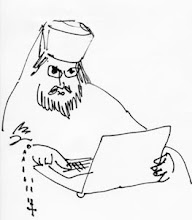 One of the pious practices most difficult for non-Orthodox to appreciate is the veneration of holy relics. This may arise in part from the prejudices many of us have gained from reading of the trade in suspect relics that went on in medieval Europe, and in part from a distaste for the veneration of dead bodies. It's worth remembering, though, that St John of Damascus, in his treatises on the holy images (icons), included holy relics among the images he was defending. This would help explain why the Reformers were intent on stripping the altars not only of images, but of relics as well. At the root of the objection to the veneration of relics, however, is the loss of an appreciation of the role of the body in salvation.
One of the pious practices most difficult for non-Orthodox to appreciate is the veneration of holy relics. This may arise in part from the prejudices many of us have gained from reading of the trade in suspect relics that went on in medieval Europe, and in part from a distaste for the veneration of dead bodies. It's worth remembering, though, that St John of Damascus, in his treatises on the holy images (icons), included holy relics among the images he was defending. This would help explain why the Reformers were intent on stripping the altars not only of images, but of relics as well. At the root of the objection to the veneration of relics, however, is the loss of an appreciation of the role of the body in salvation.The following passage, from Professor Christopher Veniamin's lecture "Theosis in Saint Silouan the Athonite and Starets Sophrony of Essex," serves as a useful introduction to this question:
Notice the following words from Father Sophrony's We Shall See Him As He Is:For more on the Orthodox veneration of holy relics, see Fr Justin Popovic's "The Place of Holy Relics in the Orthodox Church." The above photograph is of the relics of St John (Maximovich) of Shanghai and San Francisco, which repose in the Cathedral of the Joy of All Who Sorrow in San Francisco, CA.
"Through His incarnation the everlasting Logos of the Father gives us to partake of His Blood and His Flesh in order thereby to pour into our veins His eternal Life, that we may become His children, flesh of His Flesh, bone of His Bone (cf. John 6:53-57)."
In Holy Relics, therefore, we do not see dead bones — far from it. In Holy Relics we see the result of communion with the Lord, the result of sharing the very Life of the Most High God (cf. Rom. 9:5) — communion with Him Who is Self-Life, Life Itself (autozoe). United with Christ, then, though we pass through "the valley of the shadow of death" (Ps. 23:4), we pass from death to Eternal Life. This is the point at which the created meets the uncreated, the point at which earth meets "heaven face to face," and the point at which we created, mortal human beings are transfigured by Him into Divine Life.
Thus are the perfect. Thus are the saints. Thus are they whose very bones have preserved grace to the end. Holy Relics are the earthly remains of those who have been taught by none other than Christ Himself to love their enemies even unto death, the death of the Cross, which is His glory, and which by grace becomes their glory too. Love for enemies is not a moral injunction, it is the fundamental criterion for the Christian way of life. This is Salvation. Yea, this is theosis.
Truly, then, "in this world there is nothing more difficult than to be saved." But as we begin to perceive Salvation as theosis, so too do the dry bones seen by the Prophet Ezekiel begin to receive Life:
"The hand of the Lord was upon me, and carried me out in the spirit of the Lord, and set me down in the midst of the valley which was full of bones, and caused me to pass by them round about: and, behold, there were very many in the open valley; and, lo, they were very dry. And he said unto me, Son of man, can these bones live? And I answered, O Lord God, thou knowest. Again he said unto me, Prophesy upon these bones, and say unto them, O ye dry bones, hear the word of the Lord. Thus saith the Lord God unto these bones; Behold, I will cause breath to enter into you, and ye shall live: And I will lay sinews upon you, and will bring up flesh upon you, and cover you with skin, and put breath in you, and ye shall live... And ye shall know that I am the Lord, when I have opened your graves, O my people, and brought you up out of your graves, And shall put my spirit in you, and ye shall live, and I shall place you in your own land: then shall ye know that I the Lord have spoken it, and performed it, saith the Lord" (Ezek. 37:1-14).









No comments:
Post a Comment